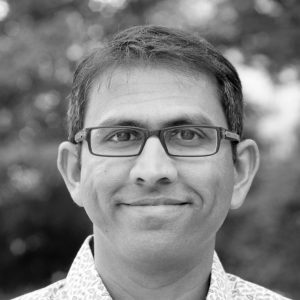
Hi Bharath, congratulations on becoming the next SRBR Public Outreach Fellow! Could you tell us a little bit about yourself?
I am an Electrical Engineer by training and a theoretical and computational biologist by profession. The common thread between my doctoral and post-doctoral work can be summed up in one word “oscillators”. I went to university in India and in California. I am currently an Independent Scientist (PI) at the Charité Medical University Berlin (on my third continent doing science).
I started in chronobiology with a study of annual reproduction in corals, but soon got involved in mammalian circadian biology. I am interested in emergent properties of clock networks (the whole is greater than the sum of the parts), regulatory architectures of clock outputs (tissue-specificity, phase regulation) and in the use of these insights for translation (e.g., single sample phase prediction). My tools are mathematical modeling, data analysis and theoretical generalizations.
What inspired you to apply for the Public Outreach fellow position?
A confluence of factors inspired me to apply. First, I was a co-first author of a blood-test to chronotype humans that generated tremendous media interest and I spoke to different media outlets, even in German. Second, I read the book “On Writing Well” by W. Zinsser that roused my interest in written communication. So, I wanted to learn more about public outreach.
Why now? Since the start of pandemic, science and scientists (especially modelers like me have been asked to make predictions) have been thrust into the spotlight. The public reception seems to be a mixture of interest and skepticism. I think it is vital for the public to understand what we do and relate to us in order to accept our recommendations.
And why chronobiology? I think chronobiology is privileged. So many of us already have intuition for chronotypes and circadian rhythms. At the same time, chronobiology has matured and produces translational research regularly now that can impact health and medicine. Finally, I think chronobiologists can have a big impact by changing people’s habits and life-styles without needing traditional medical intervention.
What plans do you have in mind for your term as the Public Outreach fellow? What would you like to achieve?
To me, outreach means both more inclusion within our community and building bridges to the lay audience. I have a few things on my mind. I love the Blitz sessions at the SRBR conference -- epitome of fun meets science. I would like to bring its essence via social media to increase visibility of young chronobiologists all year round. I think social media is a great way to provide better access and increase diversity in our community. Making SRBR social media community more dynamic would be a worthy achievement. I greatly appreciate learning about preprints and publications early, but I think we would all benefit if people also shared opinions, questions etc. Finally, I would like to introduce virtual public lectures.
I can only do this with the SRBR community. Please help me by providing ideas, comments and feedback.
What do you like to do in your spare time?
I am a history-buff and love to travel; they make a great combination. For my mental fitness, I read a certain number of books/year, listen to podcasts and do my daily cryptic crossword. For my physical fitness, I run, play racquet sports and go hiking. Caveat: my two little kids currently occupy most of my spare time.
Lastly, the most important question: what's your chronotype?
I belong to a small group of people who can answer this objectively. Our blood test showed that I had an intermediate chronotype (stable across measurements a month apart). Practically, I am flexibly a morning and evening type and I have almost never set an alarm clock in my life.
